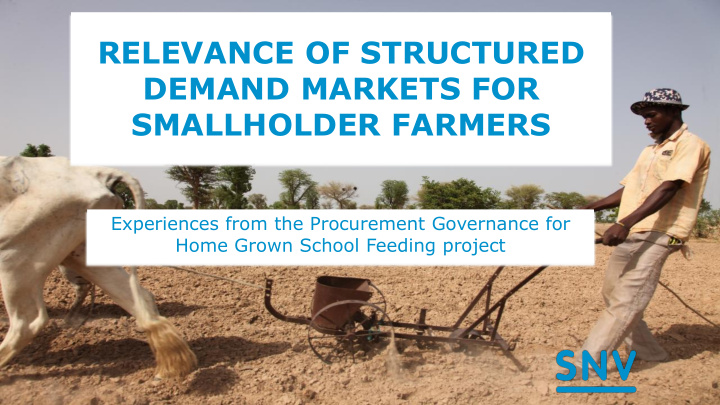



RELEVANCE OF STRUCTURED DEMAND MARKETS FOR SMALLHOLDER FARMERS Experiences from the Procurement Governance for Home Grown School Feeding project
Estimated values of some structured demand markets 70,000,000 Kenya: 103 M US$ 60,000,000 Ghana: 55 M US$ Mali: 50 M US$ 50,000,000 40,000,000 30,000,000 20,000,000 10,000,000 54,000 260,000 0 Primary education - Strategic Food Reserves - Strategic Food Reserves - WFP government school national local feeding
Relative market size of different public institutions in 6 counties in Kenya. (Extrapolation to national level: US$ 112 + million) Hospitals 2% Prisons Post Sec. Institutions 4% 5% Primary Schools 40% Sec. Schools 49%
Structured Demand: large-scale predictable demand generated through public or non-profit food procurement Reduce rural poverty and incentivize behaviour related to rural development: 1. Business development of farmer organizations 2. Investment in production technology 3. New crops or varieties 4. Opportunity for new rural businesses and off-farm job creations 5. Local private sector (traders, agrodealers, banks) see smallholder farmer as economic actor 6. Public procurement makes agricultural trade more transparent 7. New market dynamics in rural communities
Three conditions to make structured demand markets effective boosters of rural development and poverty reduction 1. Procurement process must facilitate at least equal opportunities for smallholder farmers 2. Smallholder farmers need to organize themselves in business-like organizations 3. Enabling environment needs to empower smallholder farmers, their organizations and other rural enterprises
The SD market is US$ 275 + million in Kenya, Ghana and Mali. By inducing changes on the buyers’ and sellers’ side, smallholder farmers can benefit from this economic opportunity.
Recommend
More recommend